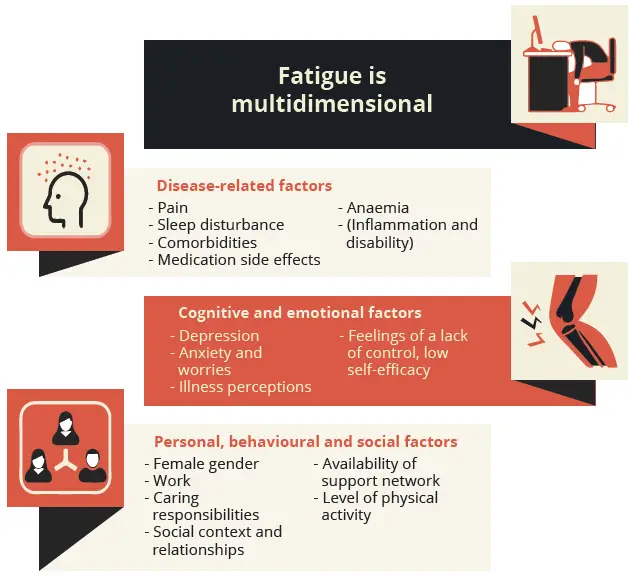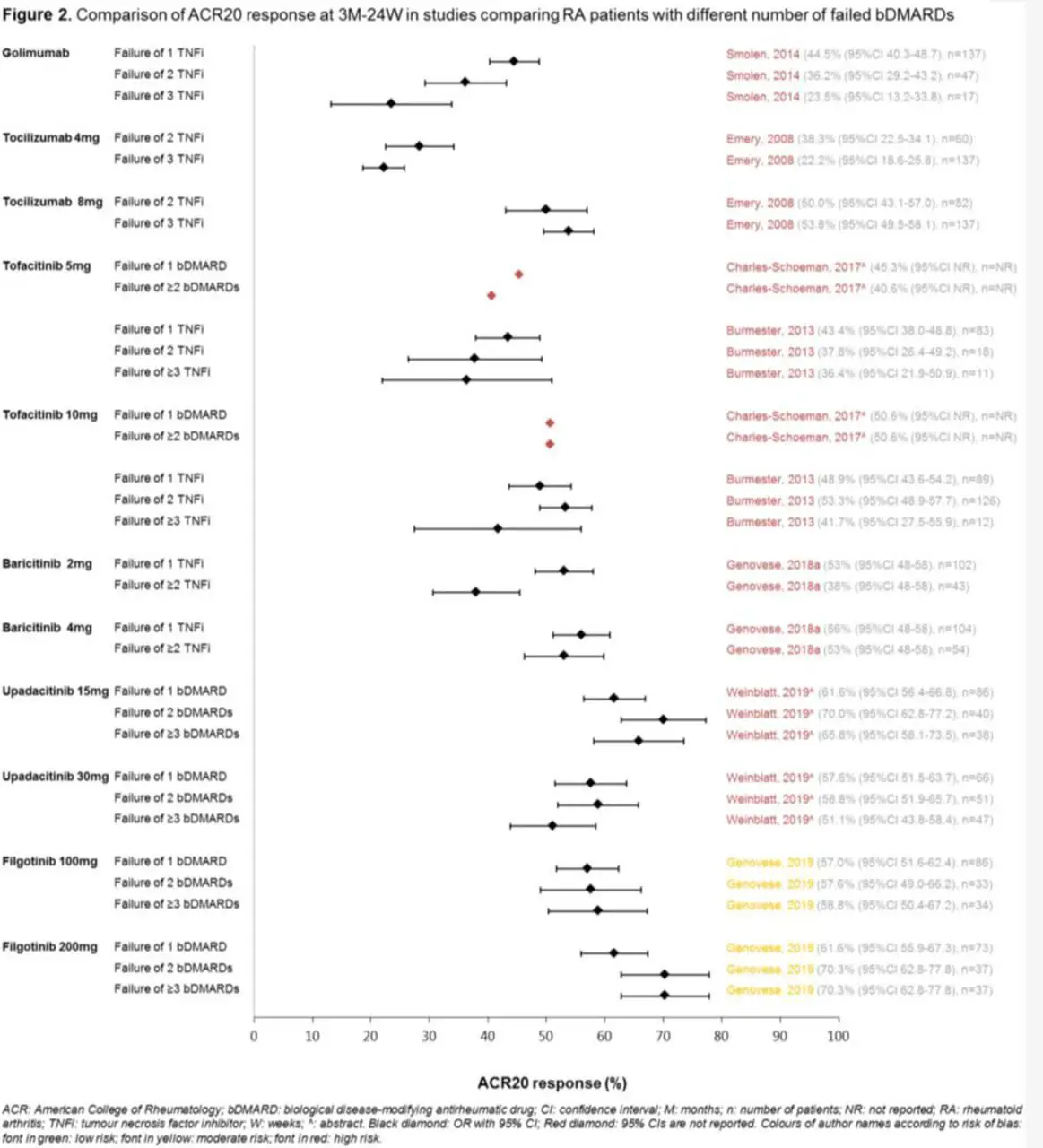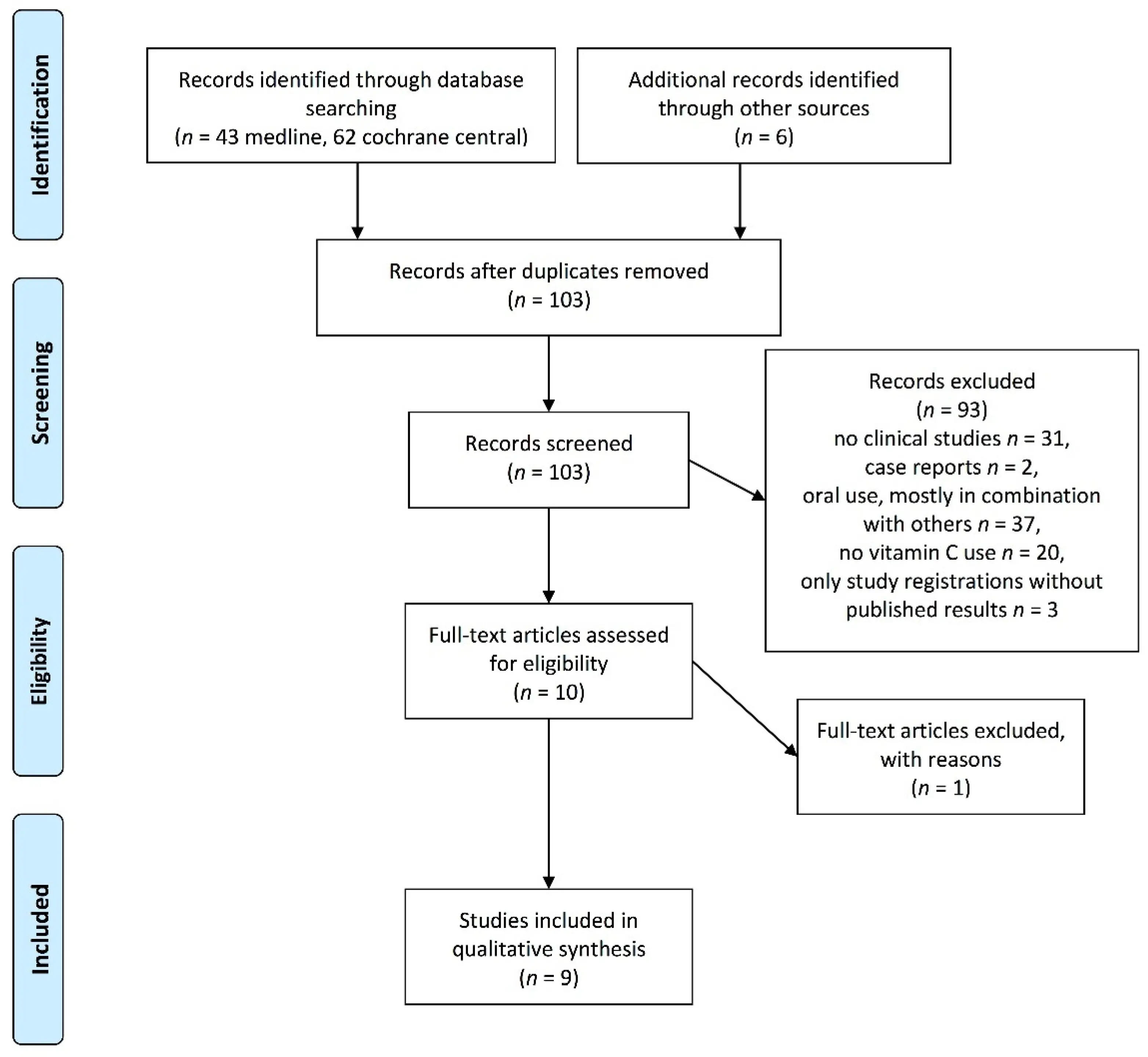Influencing Factors And Non
CHEN Qian, SHI Chunxiang, XU Jingyi
Abstract
CLC Number:
Cite this article
CHEN Qian, SHI Chunxiang, XU Jingyi. Influencing factors and non-pharmacological interventions of fatigue in patients with rheumatoid arthritis.Chinese Nursing Management, 2022, 22: 1578-1582.
Related Articles 15
What Are The Risk Factors For Developing Rheumatoid Arthritis
There are several risk factors for developing rheumatoid arthritis. These include:
- Family history: Youre more likely to develop RA if you have a close relative who also has it.
- Sex: Women and people designated female at birth are two to three times more likely to develop rheumatoid arthritis.
- Smoking:Smoking increases a persons risk of rheumatoid arthritis and makes the disease worse.
- Obesity: Your chances of developing RA are higher if you have obesity.
Remotely Delivered Cognitive Behavioural And Personalised Exercise Interventions For Fatigue Severity And Impact In Inflammatory Rheumatic Diseases : A Multicentre Randomised Controlled Open
- Lorna AucottAffiliations
- Neeraj DhaunAffiliationsBritish Heart Foundation Centre of Research Excellence, Centre for Cardiovascular Science, The Queen’s Medical Research Institute, Edinburgh, UK
- Richard EmsleyAffiliationsDepartment of Biostatistics and Health Informatics, Institute of Psychiatry, Psychology and Neuroscience, King’s College London, London, UK
- Stuart R GrayAffiliations
- Elizabeth KiddAffiliationsDepartment of Rheumatology, Freeman’s Hospital, The Newcastle upon Tyne Hospitals NHS Foundation Trust, Newcastle upon Tyne, UK
- Graeme MacLennanAffiliations
- Neil BasuCorrespondenceCorrespondence to: Prof Neil Basu, Institute of Infection, Immunity and Inflammation, University of Glasgow, Glasgow, G12 8TA, UK
- on behalf of theLIFT study group
- Study group members are listed in the appendix
Recommended Reading: Vitamin For Tiredness And Fatigue
How Is Rheumatoid Arthritis Treated
Joint damage generally occurs within the first two years of diagnosis, so its important to see your provider if you notice symptoms. Treating rheumatoid arthritis in this window of opportunity can help prevent long-term consequences.
Treatments for rheumatoid arthritis include lifestyle changes, therapies, medicine and surgery. Your provider considers your age, health, medical history and how bad your symptoms are when deciding on a treatment.
Effectiveness Of Physical Therapy

A significant decrease in pain was reported following massage therapy, but not following relaxation therapy . In addition, Tarakci et al. reported that although a 12-week exercise-based intervention significantly reduced pain , the control group had a similar reduction in pain however, exercise was more effective at improving both functional capacity and quality of life . They used a combination of strengthening, stretching and postural exercises and functional activities . In contrast, Klepper reported that pain levels did not change following an exercise intervention, using low-impact aerobic exercise to improve aerobic endurance, muscular strength, and flexibility . Both strength-building exercises and balance-proprioceptive exercises were equally effective at reducing pain and functional disability . Another study found that Pilates exercise, but not conventional exercise , significantly reduced pain, improved function, and increased quality of life . Combined resistive underwater exercise and traditional physical therapy were both found to reduce pain, but the underwater exercises were more effective . Traditional physical therapy consisted of hot packs, range-of motion, isometric and stretching exercises, and fitness exercises such as cycling and treadmill walking. All of the above-mentioned studies used a VAS pain scale, the CHAQ, and/or the PedsQL questionnaire to measure pain, functional disability, and quality of life, respectively.
You May Like: What Causes Extreme Fatigue And Hair Loss
What Medications Treat Rheumatoid Arthritis
Early treatment with certain drugs can improve your long-term outcome. Combinations of drugs may be more effective than, and appear to be as safe as, single-drug therapy.
There are many medications to decrease joint pain, swelling and inflammation, and to prevent or slow down the disease. Medications that treat rheumatoid arthritis include:
Non-steroidal anti-inflammatory drugs
Biologics tend to work rapidly within two to six weeks. Your provider may prescribe them alone or in combination with a DMARD like methotrexate.
Whats The Age Of Onset For Rheumatoid Arthritis
RA usually starts to develop between the ages of 30 and 60. But anyone can develop rheumatoid arthritis. In children and young adults usually between the ages of 16 and 40 its called young-onset rheumatoid arthritis . In people who develop symptoms after they turn 60, its called later-onset rheumatoid arthritis .
Don’t Miss: Cure For Chronic Fatigue Syndrome 2017
Balance Rest With Activity
Everyone needs to allow time for rest, and when you have RA, getting adequate rest is particularly important. However, its still important to be active.
Doing too little can also lead to fatigue, according to the Arthritis Foundation. Do some light exercise every day to help keep your joints in shape and to avoid muscle deconditioning.
This showed that physical activity can help people with RA manage fatigue. Regular exercise also can make it easier to get a good nights sleep.
A Systematic Critical Appraisal Of Non
-
Affiliation School of Rehabilitation Sciences, Faculty of Health Sciences, University of Ottawa, Ottawa, Ontario, Canada
-
Affiliation Department of Community Health and Epidemiology, Dalhousie University, Halifax, Nova Scotia, Canada
-
Affiliation School of Rehabilitation Sciences, Faculty of Health Sciences, University of Ottawa, Ottawa, Ontario, Canada
-
Affiliation Centre for Global Health, Institute of Population Health, Ottawa, Ontario, Canada
-
Affiliation The Arthritis Society, Ottawa, Ontario, Canada
-
Affiliation School of Rehabilitation Sciences, Faculty of Health Sciences, University of Ottawa, Ottawa, Ontario, Canada
-
Affiliation School of Rehabilitation Sciences, Faculty of Health Sciences, University of Ottawa, Ottawa, Ontario, Canada
-
Affiliations School of Rehabilitation Sciences, Faculty of Health Sciences, University of Ottawa, Ottawa, Ontario, Canada, Department of Academic Affairs, Montfort Hospital, Ottawa, Ontario, Canada
-
Affiliation School of Rehabilitation Sciences, Faculty of Health Sciences, University of Ottawa, Ottawa, Ontario, Canada
-
Affiliation School of Rehabilitation Sciences, Faculty of Health Sciences, University of Ottawa, Ottawa, Ontario, Canada
-
Affiliation École de Santé Publique, Université de Montréal, Montréal, Quebec, Canada
Read Also: Supplements For Muscle Fatigue And Soreness
Comparison With Previous Reports
Various aspects of non-pharmacological therapies for CMP in patients with PRD have been discussed previously. For example, Cohen et al. recently performed a meta-analysis to review the effect of psychosocial therapies on pain in PRD . However, their search was focused on psychosocial interventions and included five articles, two of which were studies involving fibromyalgia. The authors concluded that the results were, therefore, too limited to draw any meaningful conclusions. Similarly, both Takken et al. and Kuntz et al. published a review regarding the effect of exercise therapy in JIA . Although both groups reported that exercise therapy appears to be well tolerated and beneficial in terms of reducing pain and improving the function and quality of life among patients with JIA, they noted that specific clinical recommendations may be premature. One possible explanation for their inconclusive results is the heterogeneity among the patients included in the studies.
What Are The Symptoms Of Rheumatoid Arthritis
Rheumatoid arthritis affects everyone differently. In some people, joint symptoms develop over several years. In other people, rheumatoid arthritis symptoms progress rapidly. Many people have time with symptoms and then time with no symptoms .
Symptoms of rheumatoid arthritis include:
- Pain, swelling, stiffness and tenderness in more than one joint.
- Stiffness, especially in the morning or after sitting for long periods.
- Pain and stiffness in the same joints on both sides of your body.
You May Like: Ultrasoft Diamond Plate Anti Fatigue Mat
Phase : Identification Of An Existing Evidence Base
1a: review of the literature
Review 1 findings have been published elsewhere . Only two additional studies were identified since the Cochrane review . The original meta-analysis conclusion that there was a small beneficial short-term effect of PA for managing RA fatigue remained unaltered.
Review 2 concluded that aerobic PA using a graded approach might be particularly effective for managing fatigue. Optimal intervention parameters, such as duration, frequency and intensity of PA were unclear, although some evidence suggested incremental increases from a lower intensity of PA might yield better outcomes in CFS . There were limited data regarding adherence to treatment and research procedures and no qualitative studies were identified exploring acceptability of PA for fatigue in other long-term conditions.
Review 3 highlighted a lack of evidence for the effectiveness of theory-based interventions to promote engagement in and long-term maintenance of PA in RA. Interventions that promoted PA in RA employed a range of BCTs, including instruction on how to perform the behaviour, information provision, goal setting, problem-solving, feedback and self-monitoring. Although some studies specified or alluded to health behaviour change theories, it was unclear if or how theory was used during intervention development.
1b: qualitative exploration of PA programmes in other long-term conditions
Format
Delivery
Organisational flexibility
Dont Take It Personally

Recognize that feeling tired can be a part of having RA. If you experience this symptom, understand that its not weakness on your part. Fatigue is something that many with RA experience.
Its important to understand this and to make any necessary changes, rather than deny the fatigue youre experiencing. If youre realistic about your condition and symptoms, youre more likely to lessen or overcome your fatigue.
You May Like: Amazon Anti Fatigue Kitchen Mats
Research Results In Brief
Physical Activity
Within the 4 studies focusing on physical activity interventions, 3 identified fatigue as either a primary or joint primary outcome. One study7 that investigated a home exercise plan was individualized to target participant-identified functional limitations however, this study made no reference to fatigue mechanisms in either the design or implementation of the intervention. Another study5 that employed a pedometer intervention had the goal of increasing participant physical activity.
A third study examined the use of a person-centered physical therapy intervention, focused on health-enhancing physical activity and balanced lifestyle activities. The investigators suggested that this approach might both strengthen confidence and help manage fatigue as well as disease-related, fatigue-associated symptoms.
Overall, 3 of the 4 studies4,6,7 reported significant improvements in fatigue at the end of each respective intervention compared with the control groups. In the fourth study,5 researchers demonstrated a fatigue reduction in both groups that received pedometers to record daily step count, but outcomes were not significantly different from control group outcomes.
Psychosocial Interventions
Aromatherapy and Reflexology
Ethics Approval And Consent To Participate
We confirm that all studies have been approved by the appropriate ethics committees and have been performed in accordance with the ethical standards laid down in the 1964 Declaration of Helsinki and its later amendments. We confirm that all persons gave informed written consent prior to their inclusion in the study. Details that might disclose the identity of the subjects under study have been omitted.
Ethics approval for studies in this manuscript was obtained from the following committees:
-
Phase 1b: approved by The University of the West of England Faculty of Health and Applied Sciences Research Ethics Committee
-
Phase 2: approved by the National Research Ethics Service Committee East Midlands – Nottingham 1 .
Also Check: Saline Iv For Chronic Fatigue
Will Changing My Diet Help My Rheumatoid Arthritis
When combined with the treatments and medications your provider recommends, changes in diet may help reduce inflammation and other symptoms of RA. But it wont cure you. You can talk with your doctor about adding good fats and minimizing bad fats, salt and processed carbohydrates. No herbal or nutritional supplements, like collagen, can cure rheumatoid arthritis. These dietary changes are safer and most successful when monitored by your rheumatologist.
But there are lifestyle changes you can make that may help relieve your symptoms. Your rheumatologist may recommend weight loss to reduce stress on inflamed joints.
People with rheumatoid arthritis also have a higher risk of coronary artery disease. High blood cholesterol can respond to changes in diet. A nutritionist can recommend specific foods to eat or avoid to reach a desirable cholesterol level.
Phase : Identification Of Preferences Of Ra Patients And Rheumatology Hcps
All phase 2 participants supported the use of PA for managing RA fatigue. Key themes relating to challenges and solutions for implementation concerned group and peer support, patient-centred delivery, accessibility and knowledge and skills.
Group and peer support
All participants felt that PA interventions should be delivered face-to-face in groups. Patients considered groups extremely valuable, providing an opportunity for interaction and discussion with fellow patients, as well as HCPs, who could offer expert advice and reassurance, enhancing confidence with managing fatigue and modifying PA. They felt that a group format was key for problem solving and learning through peer support. HCP participants agreed that group sessions had the advantage of offering peer support and felt they could be justified from a management perspective. However, lack of staff and limited resources may prohibit group sessions in some services.
Patient-centred delivery
Accessibility
Patient preferences for location varied between community and hospital settings. Participants recruited from an inner-city hospital indicated that available transport options may influence their decision to attend a programme.
Knowledge and skills
Read Also: Can Coffee Cause Extreme Fatigue
Implications For Future Research
With regard to future research, several aspects are worth mentioning. First, future studies should differentiate between acute and chronic pain, as these two types of pain differ with respect to the underlying pathophysiology. Second, studies that combine a graded exercise therapy with cognitive behavioral interventions to achieve change in the perception of pain might be a feasible approach for restoring functional capacity, increasing social participation, and reducing pain . Third, based on the biopsychosocial model, we hypothesized that CBT may be highly effective however, we were unable to test this hypothesis due to the limited number of studies available. Thus, gaining further insight into the relationship between an individual childs thinking, feeling, and behavior might be necessary to tailor the cognitive behavioral intervention to that particular child for the psychological intervention to be effective. Finally, even though follow-up studies are extremely important, only one of the eleven studies in our analysis reported follow-up data . An improvement in functioning often precedes a reduction in pain . Therefore, any reduction in pain might be more evident at later time points than immediately following treatment. Given that most of the studies in our analysis were published in 2010 or more recently, follow-up data may still be on the way, and opportunities for future research are numerous in this still-evolving field.
What Types Of Lifestyle Changes Can Help With Rheumatoid Arthritis
Having a lifelong illness like rheumatoid arthritis may make you feel like you dont have much control over your quality of life. While there are aspects of RA that you cant control, there are things you can do to help you feel the best that you can.
Such lifestyle changes include:
Rest
When your joints are inflamed, the risk of injury to your joints and nearby soft tissue structures is high. This is why you need to rest your inflamed joints. But its still important for you to exercise. Maintaining a good range of motion in your joints and good fitness overall are important in coping with RA.
Exercise
Pain and stiffness can slow you down. Some people with rheumatoid arthritis become inactive. But inactivity can lead to a loss of joint motion and loss of muscle strength. These, in turn, decrease joint stability and increase pain and fatigue.
Regular exercise can help prevent and reverse these effects. You might want to start by seeing a physical or occupational therapist for advice about how to exercise safely. Beneficial workouts include:
- Range-of-motion exercises to preserve and restore joint motion.
- Exercises to increase strength.
- Exercises to increase endurance .
Read Also: How Long Does Fatigue Last After Chemo And Radiation
Study Design And Participants
BMJ Open.
Data Extraction And Quality Assessment

Information on study design, patient characteristics, interventions, comparators and outcomes were extracted from the included papers using a predetermined format .
Risk of bias of the original papers was assessed using the Cochrane Collaborations risk of bias tool, and highest RoB as found was reported here . For the questions on the identification of suboptimal goal setting and self-management , RoB was assessed using the Quality Assessment of Diagnostic Accuracy Studies tool version 2 , and highest RoB as found was reported . For SLRs, A MeaSurement Tool to Assess systematic Reviews version 2 was used and overall RoB was reported according to the AMSTAR-2 scoring system .
Data extraction and quality assessment were performed in duplicate by the fellows until the number of conflicts was below 5%. Disagreements and remaining doubts were discussed with the co-methodologist until consensus was reached.
Recommended Reading: Can Back Pain Cause Fatigue
What Are The Goals Of Treating Rheumatoid Arthritis
The most important goal of treating rheumatoid arthritis is to reduce joint pain and swelling. Doing so should help maintain or improve joint function. The long-term goal of treatment is to slow or stop joint damage. Controlling joint inflammation reduces your pain and improves your quality of life.
What Are The Four Stages Of Rheumatoid Arthritis
- Stage 1: In early stage rheumatoid arthritis, the tissue around your joint is inflamed. You may have some pain and stiffness. If your provider ordered X-rays, they wouldnt see destructive changes in your bones.
- Stage 2: The inflammation has begun to damage the cartilage in your joints. You might notice stiffness and a decreased range of motion.
- Stage 3: The inflammation is so severe that it damages your bones. Youll have more pain, stiffness and even less range of motion than in stage 2, and you may start to see physical changes.
- Stage 4: In this stage, the inflammation stops but your joints keep getting worse. Youll have severe pain, swelling, stiffness and loss of mobility.
Don’t Miss: Can Chronic Kidney Disease Cause Fatigue